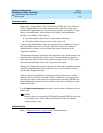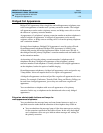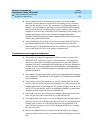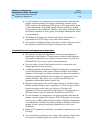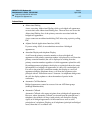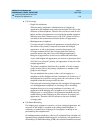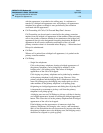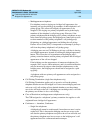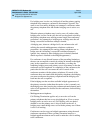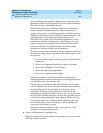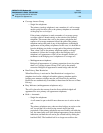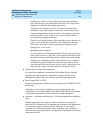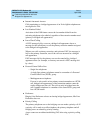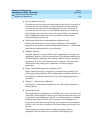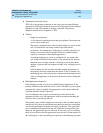
DEFINITY ECS Release 8.2
Administrator’s Guide
555-233-506
Issue 1
April 2000
Features and technical reference
1180Bridged Call Appearance
20
— Multiappearance telephones
If a telephone receives ringing on a bridged call appearance, the
incoming call can be picked up by members of that telephone’s call
pickup group. This causes all bridged call appearances to be
dropped. Calls ringing at a primary telephone can be picked up by
members of the telephone’s call pickup group. However, if the
primary telephone and the bridging user’s primary telephone are not
in the same call pickup group, the bridging user cannot pick up calls
to other members of the primary telephone’s call pickup group.
Originating on a bridged appearance and dialing the call pickup
Feature Access Code (FAC) is interpreted as an attempt to pick up a
call from the primary telephone’s call pickup group.
A bridging user can use Call Pickup to pick up a call that is alerting
at a bridged appearance, instead of selecting the bridged appearance
button. This causes the call to terminate on the bridging user’s
primary extension button, and the primary telephone and all bridged
appearances of the call are dropped.
If the bridging user has appearances of numerous telephones (for
example, sales, service, and warehouse), and it is not desired that the
calls be answered by anyone other than the telephone user or the
bridging users, the bridging users should not be assigned to a pick
up group.
A telephone with zero primary call appearances can be assigned to a
call pickup group.
■ Call Waiting Termination (single-line telephones only)
Call Waiting Termination applies only to an active call on the primary
telephone that has no one else bridged on. If one or more bridging users are
active on a call, call waiting calls are denied whether or not the primary
user is also off-hook on the call. A bridging user can bridge onto a call with
the primary user if there is also a call waiting.
■ Class of Restriction (multiappearance telephone users only)
The COR assigned to a telephone’s primary extension also applies to calls
originated from a bridged call appearance.
■ Conference — Attendant, Conference
— Single-line telephones
A bridged call cannot be conferenced if more than one user is active
on that call. This is because the bridging user has no access to the
call after the primary telephone user places the call on soft hold, and
the primary telephone user has no access to the bridging user’s call
appearance used for conference/transfer attempts.




